Leadership Report: Addressing Challenging Behaviors in Australia
VerifiedAdded on 2020/10/22
|8
|2217
|429
Report
AI Summary
This report provides an analysis of challenging behaviors observed within a team setting in Australia, focusing on the role of a team coordinator. It explores the definition of challenging behavior and its impact on team dynamics, including conflicts, duplication of work, and communication issues. The report highlights the duties and responsibilities of a team coordinator and identifies specific challenging behaviors exhibited, such as egoistic nature, lack of communication, and non-collaborative tendencies. It examines the factors contributing to these behaviors and their consequences on team performance, including reduced motivation and decreased efficiency. The report also discusses methods for preventing and addressing challenging behaviors, referencing real-life examples and emphasizing the importance of leadership in fostering a positive and productive work environment. It concludes by reiterating the significance of recognizing and managing challenging behaviors to promote effective teamwork and achieve organizational goals. The report also includes references to relevant literature on the subject.
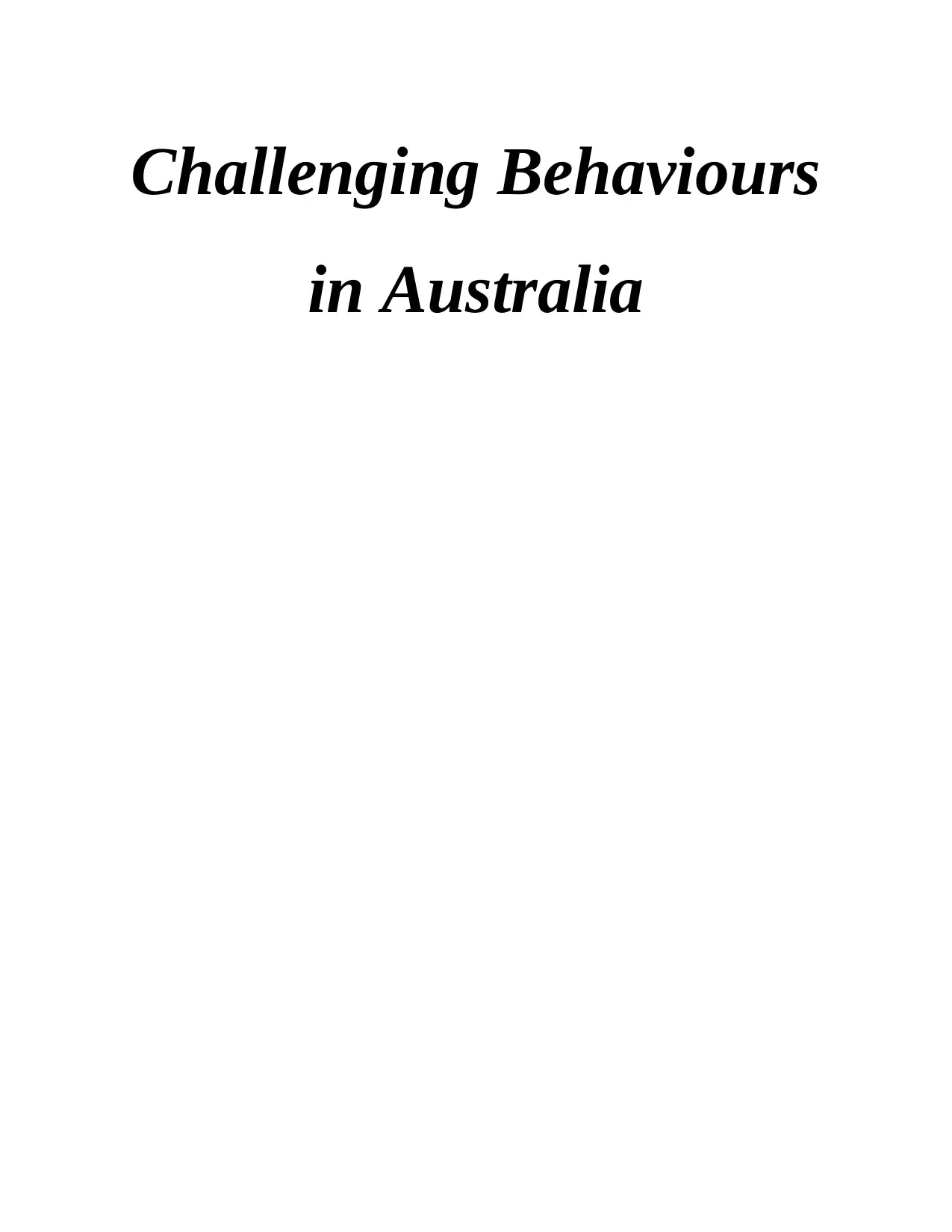
Challenging Behaviours
in Australia
in Australia
Paraphrase This Document
Need a fresh take? Get an instant paraphrase of this document with our AI Paraphraser
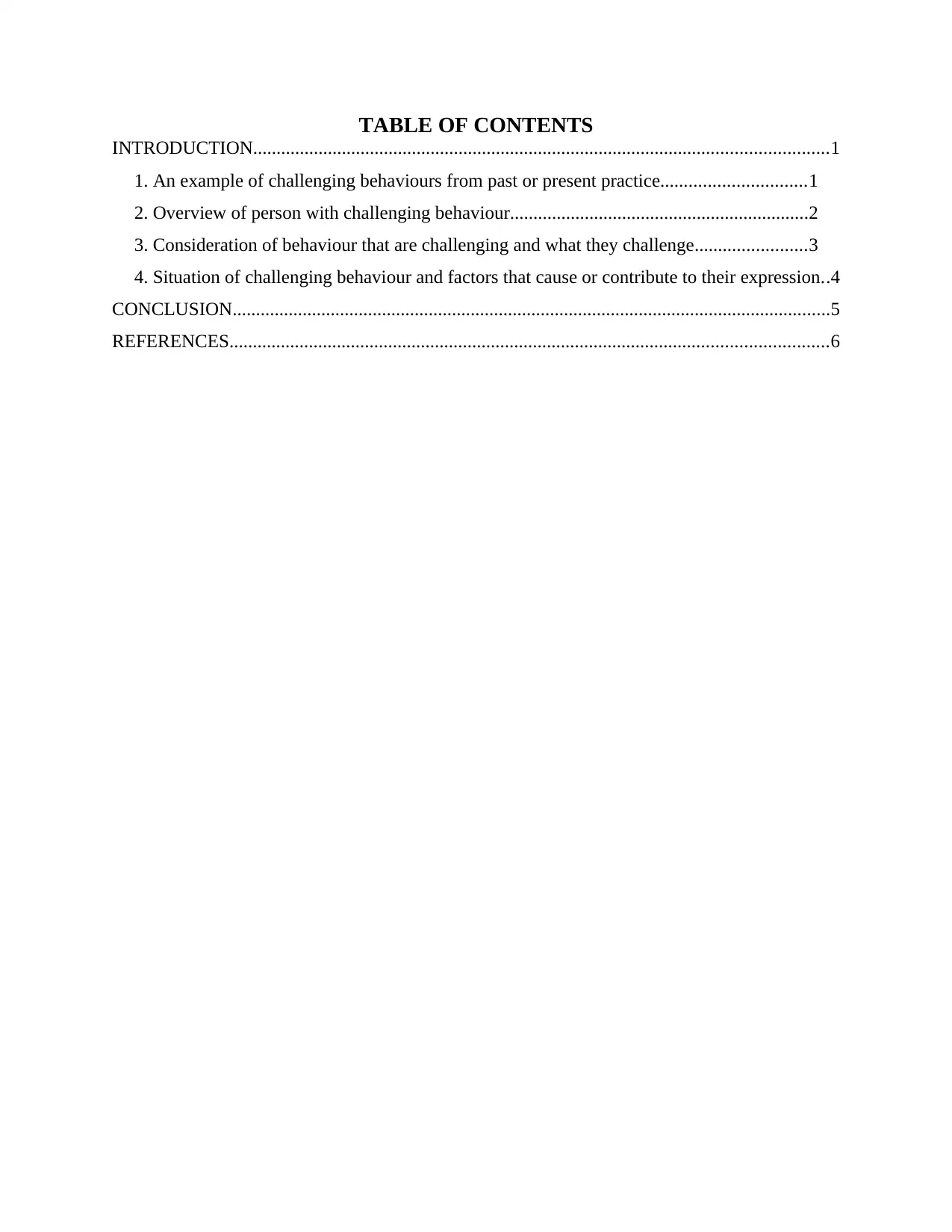
TABLE OF CONTENTS
INTRODUCTION...........................................................................................................................1
1. An example of challenging behaviours from past or present practice...............................1
2. Overview of person with challenging behaviour................................................................2
3. Consideration of behaviour that are challenging and what they challenge........................3
4. Situation of challenging behaviour and factors that cause or contribute to their expression..4
CONCLUSION................................................................................................................................5
REFERENCES................................................................................................................................6
INTRODUCTION...........................................................................................................................1
1. An example of challenging behaviours from past or present practice...............................1
2. Overview of person with challenging behaviour................................................................2
3. Consideration of behaviour that are challenging and what they challenge........................3
4. Situation of challenging behaviour and factors that cause or contribute to their expression..4
CONCLUSION................................................................................................................................5
REFERENCES................................................................................................................................6
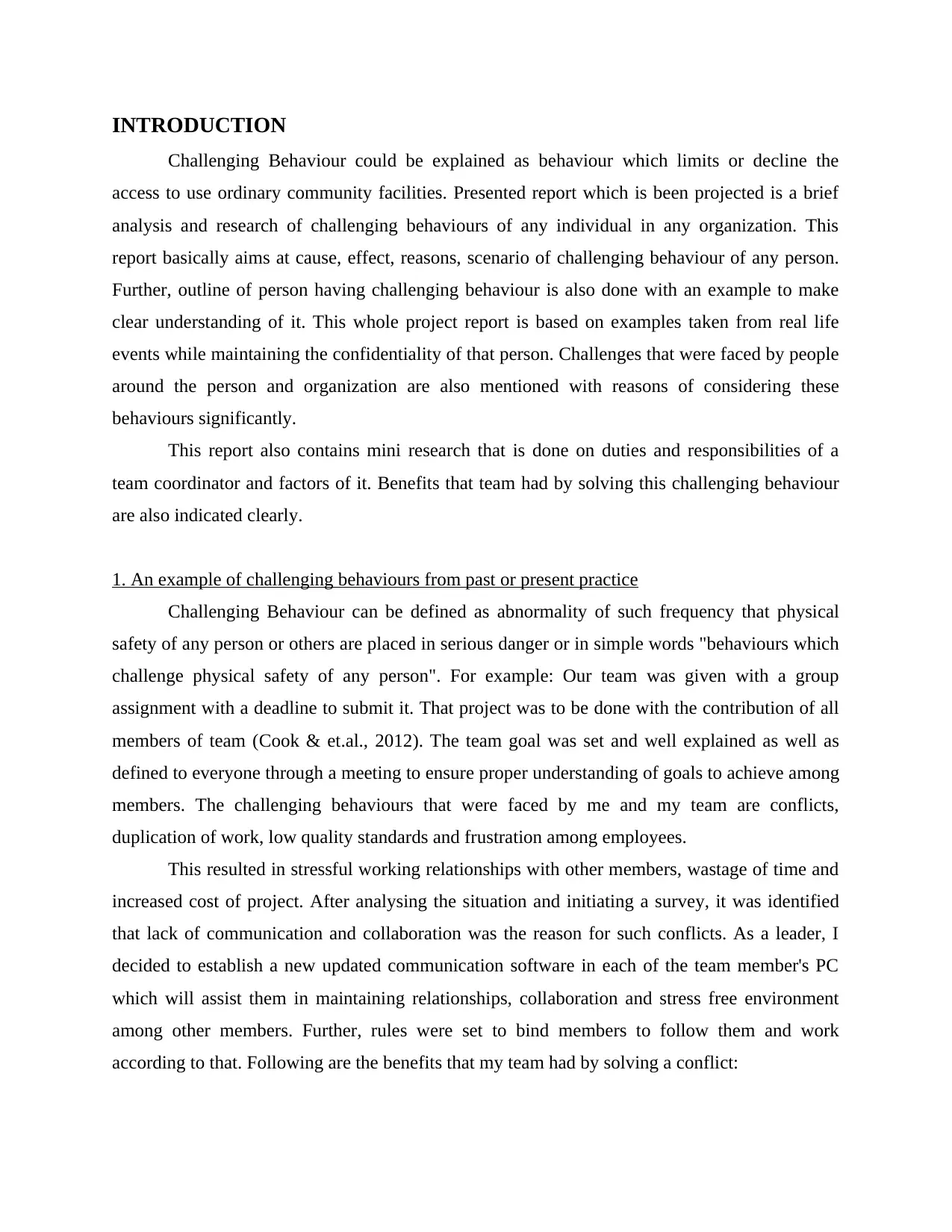
INTRODUCTION
Challenging Behaviour could be explained as behaviour which limits or decline the
access to use ordinary community facilities. Presented report which is been projected is a brief
analysis and research of challenging behaviours of any individual in any organization. This
report basically aims at cause, effect, reasons, scenario of challenging behaviour of any person.
Further, outline of person having challenging behaviour is also done with an example to make
clear understanding of it. This whole project report is based on examples taken from real life
events while maintaining the confidentiality of that person. Challenges that were faced by people
around the person and organization are also mentioned with reasons of considering these
behaviours significantly.
This report also contains mini research that is done on duties and responsibilities of a
team coordinator and factors of it. Benefits that team had by solving this challenging behaviour
are also indicated clearly.
1. An example of challenging behaviours from past or present practice
Challenging Behaviour can be defined as abnormality of such frequency that physical
safety of any person or others are placed in serious danger or in simple words "behaviours which
challenge physical safety of any person". For example: Our team was given with a group
assignment with a deadline to submit it. That project was to be done with the contribution of all
members of team (Cook & et.al., 2012). The team goal was set and well explained as well as
defined to everyone through a meeting to ensure proper understanding of goals to achieve among
members. The challenging behaviours that were faced by me and my team are conflicts,
duplication of work, low quality standards and frustration among employees.
This resulted in stressful working relationships with other members, wastage of time and
increased cost of project. After analysing the situation and initiating a survey, it was identified
that lack of communication and collaboration was the reason for such conflicts. As a leader, I
decided to establish a new updated communication software in each of the team member's PC
which will assist them in maintaining relationships, collaboration and stress free environment
among other members. Further, rules were set to bind members to follow them and work
according to that. Following are the benefits that my team had by solving a conflict:
Challenging Behaviour could be explained as behaviour which limits or decline the
access to use ordinary community facilities. Presented report which is been projected is a brief
analysis and research of challenging behaviours of any individual in any organization. This
report basically aims at cause, effect, reasons, scenario of challenging behaviour of any person.
Further, outline of person having challenging behaviour is also done with an example to make
clear understanding of it. This whole project report is based on examples taken from real life
events while maintaining the confidentiality of that person. Challenges that were faced by people
around the person and organization are also mentioned with reasons of considering these
behaviours significantly.
This report also contains mini research that is done on duties and responsibilities of a
team coordinator and factors of it. Benefits that team had by solving this challenging behaviour
are also indicated clearly.
1. An example of challenging behaviours from past or present practice
Challenging Behaviour can be defined as abnormality of such frequency that physical
safety of any person or others are placed in serious danger or in simple words "behaviours which
challenge physical safety of any person". For example: Our team was given with a group
assignment with a deadline to submit it. That project was to be done with the contribution of all
members of team (Cook & et.al., 2012). The team goal was set and well explained as well as
defined to everyone through a meeting to ensure proper understanding of goals to achieve among
members. The challenging behaviours that were faced by me and my team are conflicts,
duplication of work, low quality standards and frustration among employees.
This resulted in stressful working relationships with other members, wastage of time and
increased cost of project. After analysing the situation and initiating a survey, it was identified
that lack of communication and collaboration was the reason for such conflicts. As a leader, I
decided to establish a new updated communication software in each of the team member's PC
which will assist them in maintaining relationships, collaboration and stress free environment
among other members. Further, rules were set to bind members to follow them and work
according to that. Following are the benefits that my team had by solving a conflict:
⊘ This is a preview!⊘
Do you want full access?
Subscribe today to unlock all pages.

Trusted by 1+ million students worldwide
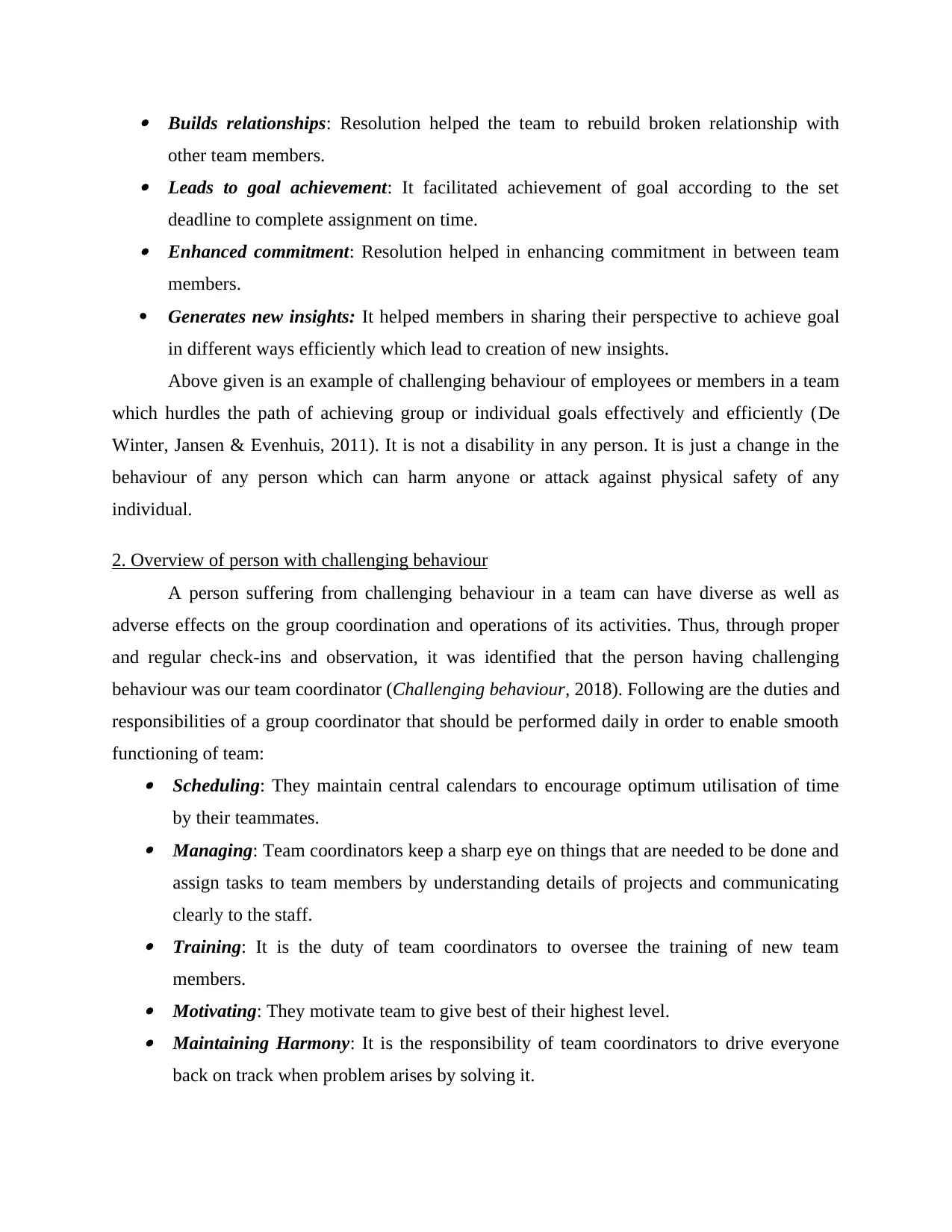
Builds relationships: Resolution helped the team to rebuild broken relationship with
other team members. Leads to goal achievement: It facilitated achievement of goal according to the set
deadline to complete assignment on time. Enhanced commitment: Resolution helped in enhancing commitment in between team
members.
Generates new insights: It helped members in sharing their perspective to achieve goal
in different ways efficiently which lead to creation of new insights.
Above given is an example of challenging behaviour of employees or members in a team
which hurdles the path of achieving group or individual goals effectively and efficiently (De
Winter, Jansen & Evenhuis, 2011). It is not a disability in any person. It is just a change in the
behaviour of any person which can harm anyone or attack against physical safety of any
individual.
2. Overview of person with challenging behaviour
A person suffering from challenging behaviour in a team can have diverse as well as
adverse effects on the group coordination and operations of its activities. Thus, through proper
and regular check-ins and observation, it was identified that the person having challenging
behaviour was our team coordinator (Challenging behaviour, 2018). Following are the duties and
responsibilities of a group coordinator that should be performed daily in order to enable smooth
functioning of team: Scheduling: They maintain central calendars to encourage optimum utilisation of time
by their teammates. Managing: Team coordinators keep a sharp eye on things that are needed to be done and
assign tasks to team members by understanding details of projects and communicating
clearly to the staff. Training: It is the duty of team coordinators to oversee the training of new team
members. Motivating: They motivate team to give best of their highest level. Maintaining Harmony: It is the responsibility of team coordinators to drive everyone
back on track when problem arises by solving it.
other team members. Leads to goal achievement: It facilitated achievement of goal according to the set
deadline to complete assignment on time. Enhanced commitment: Resolution helped in enhancing commitment in between team
members.
Generates new insights: It helped members in sharing their perspective to achieve goal
in different ways efficiently which lead to creation of new insights.
Above given is an example of challenging behaviour of employees or members in a team
which hurdles the path of achieving group or individual goals effectively and efficiently (De
Winter, Jansen & Evenhuis, 2011). It is not a disability in any person. It is just a change in the
behaviour of any person which can harm anyone or attack against physical safety of any
individual.
2. Overview of person with challenging behaviour
A person suffering from challenging behaviour in a team can have diverse as well as
adverse effects on the group coordination and operations of its activities. Thus, through proper
and regular check-ins and observation, it was identified that the person having challenging
behaviour was our team coordinator (Challenging behaviour, 2018). Following are the duties and
responsibilities of a group coordinator that should be performed daily in order to enable smooth
functioning of team: Scheduling: They maintain central calendars to encourage optimum utilisation of time
by their teammates. Managing: Team coordinators keep a sharp eye on things that are needed to be done and
assign tasks to team members by understanding details of projects and communicating
clearly to the staff. Training: It is the duty of team coordinators to oversee the training of new team
members. Motivating: They motivate team to give best of their highest level. Maintaining Harmony: It is the responsibility of team coordinators to drive everyone
back on track when problem arises by solving it.
Paraphrase This Document
Need a fresh take? Get an instant paraphrase of this document with our AI Paraphraser
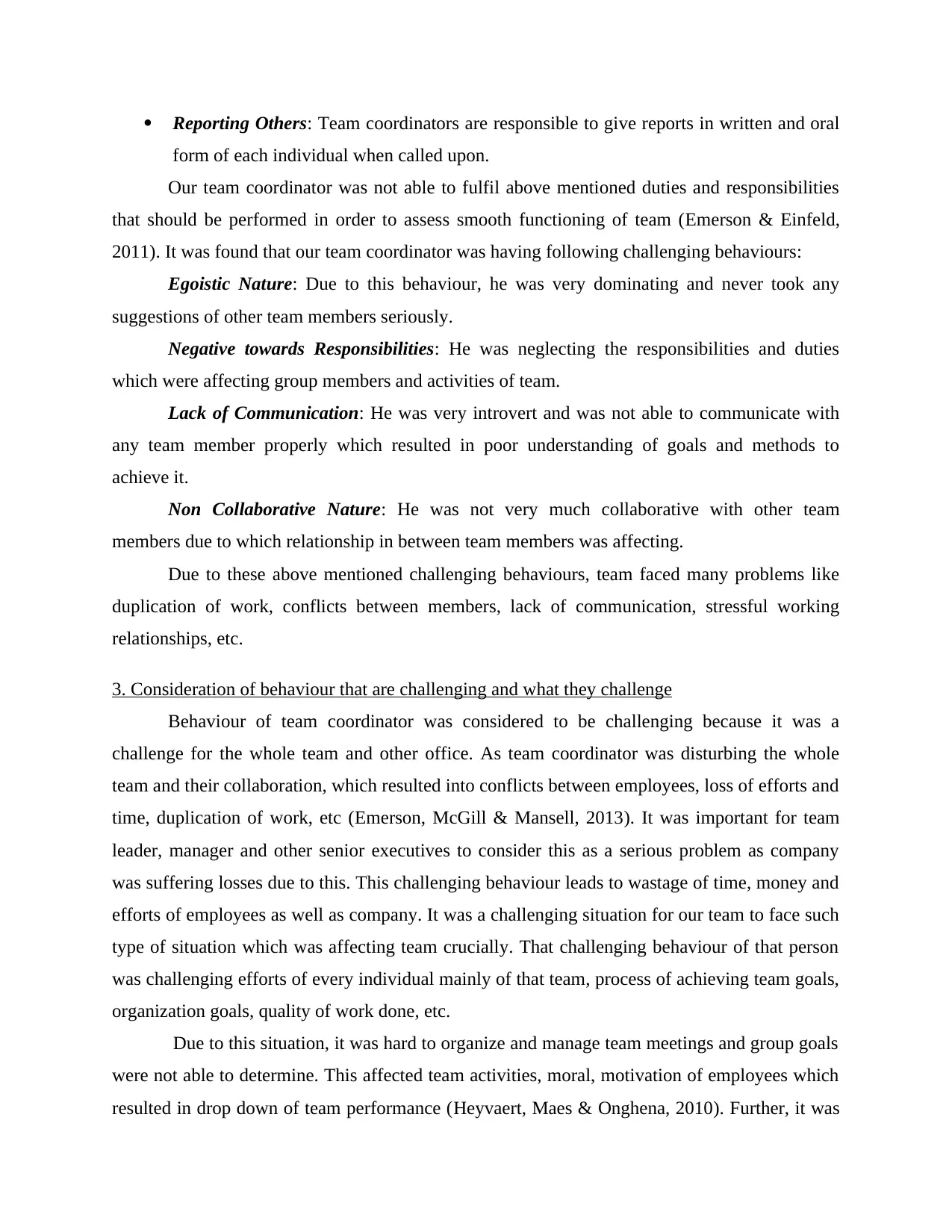
Reporting Others: Team coordinators are responsible to give reports in written and oral
form of each individual when called upon.
Our team coordinator was not able to fulfil above mentioned duties and responsibilities
that should be performed in order to assess smooth functioning of team (Emerson & Einfeld,
2011). It was found that our team coordinator was having following challenging behaviours:
Egoistic Nature: Due to this behaviour, he was very dominating and never took any
suggestions of other team members seriously.
Negative towards Responsibilities: He was neglecting the responsibilities and duties
which were affecting group members and activities of team.
Lack of Communication: He was very introvert and was not able to communicate with
any team member properly which resulted in poor understanding of goals and methods to
achieve it.
Non Collaborative Nature: He was not very much collaborative with other team
members due to which relationship in between team members was affecting.
Due to these above mentioned challenging behaviours, team faced many problems like
duplication of work, conflicts between members, lack of communication, stressful working
relationships, etc.
3. Consideration of behaviour that are challenging and what they challenge
Behaviour of team coordinator was considered to be challenging because it was a
challenge for the whole team and other office. As team coordinator was disturbing the whole
team and their collaboration, which resulted into conflicts between employees, loss of efforts and
time, duplication of work, etc (Emerson, McGill & Mansell, 2013). It was important for team
leader, manager and other senior executives to consider this as a serious problem as company
was suffering losses due to this. This challenging behaviour leads to wastage of time, money and
efforts of employees as well as company. It was a challenging situation for our team to face such
type of situation which was affecting team crucially. That challenging behaviour of that person
was challenging efforts of every individual mainly of that team, process of achieving team goals,
organization goals, quality of work done, etc.
Due to this situation, it was hard to organize and manage team meetings and group goals
were not able to determine. This affected team activities, moral, motivation of employees which
resulted in drop down of team performance (Heyvaert, Maes & Onghena, 2010). Further, it was
form of each individual when called upon.
Our team coordinator was not able to fulfil above mentioned duties and responsibilities
that should be performed in order to assess smooth functioning of team (Emerson & Einfeld,
2011). It was found that our team coordinator was having following challenging behaviours:
Egoistic Nature: Due to this behaviour, he was very dominating and never took any
suggestions of other team members seriously.
Negative towards Responsibilities: He was neglecting the responsibilities and duties
which were affecting group members and activities of team.
Lack of Communication: He was very introvert and was not able to communicate with
any team member properly which resulted in poor understanding of goals and methods to
achieve it.
Non Collaborative Nature: He was not very much collaborative with other team
members due to which relationship in between team members was affecting.
Due to these above mentioned challenging behaviours, team faced many problems like
duplication of work, conflicts between members, lack of communication, stressful working
relationships, etc.
3. Consideration of behaviour that are challenging and what they challenge
Behaviour of team coordinator was considered to be challenging because it was a
challenge for the whole team and other office. As team coordinator was disturbing the whole
team and their collaboration, which resulted into conflicts between employees, loss of efforts and
time, duplication of work, etc (Emerson, McGill & Mansell, 2013). It was important for team
leader, manager and other senior executives to consider this as a serious problem as company
was suffering losses due to this. This challenging behaviour leads to wastage of time, money and
efforts of employees as well as company. It was a challenging situation for our team to face such
type of situation which was affecting team crucially. That challenging behaviour of that person
was challenging efforts of every individual mainly of that team, process of achieving team goals,
organization goals, quality of work done, etc.
Due to this situation, it was hard to organize and manage team meetings and group goals
were not able to determine. This affected team activities, moral, motivation of employees which
resulted in drop down of team performance (Heyvaert, Maes & Onghena, 2010). Further, it was
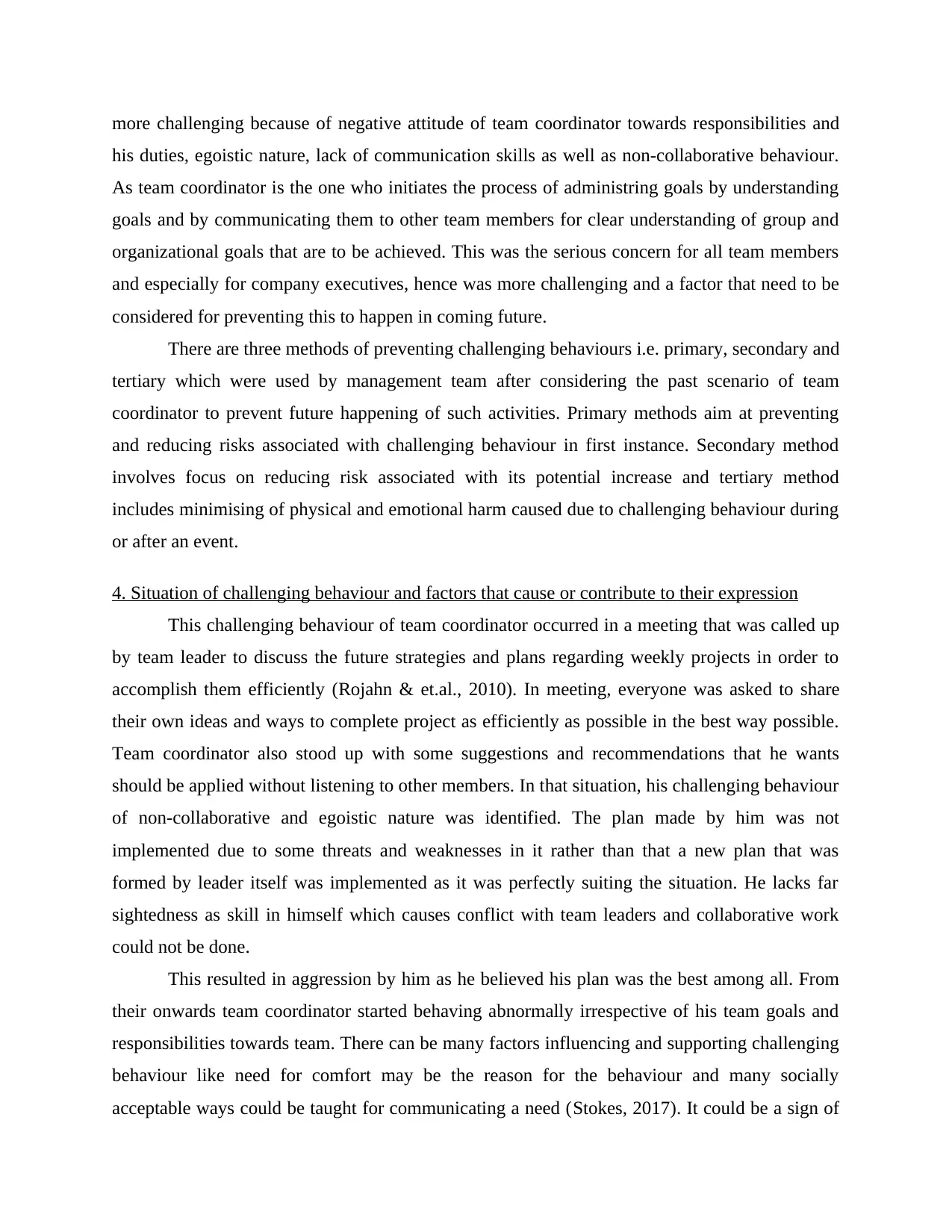
more challenging because of negative attitude of team coordinator towards responsibilities and
his duties, egoistic nature, lack of communication skills as well as non-collaborative behaviour.
As team coordinator is the one who initiates the process of administring goals by understanding
goals and by communicating them to other team members for clear understanding of group and
organizational goals that are to be achieved. This was the serious concern for all team members
and especially for company executives, hence was more challenging and a factor that need to be
considered for preventing this to happen in coming future.
There are three methods of preventing challenging behaviours i.e. primary, secondary and
tertiary which were used by management team after considering the past scenario of team
coordinator to prevent future happening of such activities. Primary methods aim at preventing
and reducing risks associated with challenging behaviour in first instance. Secondary method
involves focus on reducing risk associated with its potential increase and tertiary method
includes minimising of physical and emotional harm caused due to challenging behaviour during
or after an event.
4. Situation of challenging behaviour and factors that cause or contribute to their expression
This challenging behaviour of team coordinator occurred in a meeting that was called up
by team leader to discuss the future strategies and plans regarding weekly projects in order to
accomplish them efficiently (Rojahn & et.al., 2010). In meeting, everyone was asked to share
their own ideas and ways to complete project as efficiently as possible in the best way possible.
Team coordinator also stood up with some suggestions and recommendations that he wants
should be applied without listening to other members. In that situation, his challenging behaviour
of non-collaborative and egoistic nature was identified. The plan made by him was not
implemented due to some threats and weaknesses in it rather than that a new plan that was
formed by leader itself was implemented as it was perfectly suiting the situation. He lacks far
sightedness as skill in himself which causes conflict with team leaders and collaborative work
could not be done.
This resulted in aggression by him as he believed his plan was the best among all. From
their onwards team coordinator started behaving abnormally irrespective of his team goals and
responsibilities towards team. There can be many factors influencing and supporting challenging
behaviour like need for comfort may be the reason for the behaviour and many socially
acceptable ways could be taught for communicating a need (Stokes, 2017). It could be a sign of
his duties, egoistic nature, lack of communication skills as well as non-collaborative behaviour.
As team coordinator is the one who initiates the process of administring goals by understanding
goals and by communicating them to other team members for clear understanding of group and
organizational goals that are to be achieved. This was the serious concern for all team members
and especially for company executives, hence was more challenging and a factor that need to be
considered for preventing this to happen in coming future.
There are three methods of preventing challenging behaviours i.e. primary, secondary and
tertiary which were used by management team after considering the past scenario of team
coordinator to prevent future happening of such activities. Primary methods aim at preventing
and reducing risks associated with challenging behaviour in first instance. Secondary method
involves focus on reducing risk associated with its potential increase and tertiary method
includes minimising of physical and emotional harm caused due to challenging behaviour during
or after an event.
4. Situation of challenging behaviour and factors that cause or contribute to their expression
This challenging behaviour of team coordinator occurred in a meeting that was called up
by team leader to discuss the future strategies and plans regarding weekly projects in order to
accomplish them efficiently (Rojahn & et.al., 2010). In meeting, everyone was asked to share
their own ideas and ways to complete project as efficiently as possible in the best way possible.
Team coordinator also stood up with some suggestions and recommendations that he wants
should be applied without listening to other members. In that situation, his challenging behaviour
of non-collaborative and egoistic nature was identified. The plan made by him was not
implemented due to some threats and weaknesses in it rather than that a new plan that was
formed by leader itself was implemented as it was perfectly suiting the situation. He lacks far
sightedness as skill in himself which causes conflict with team leaders and collaborative work
could not be done.
This resulted in aggression by him as he believed his plan was the best among all. From
their onwards team coordinator started behaving abnormally irrespective of his team goals and
responsibilities towards team. There can be many factors influencing and supporting challenging
behaviour like need for comfort may be the reason for the behaviour and many socially
acceptable ways could be taught for communicating a need (Stokes, 2017). It could be a sign of
⊘ This is a preview!⊘
Do you want full access?
Subscribe today to unlock all pages.

Trusted by 1+ million students worldwide
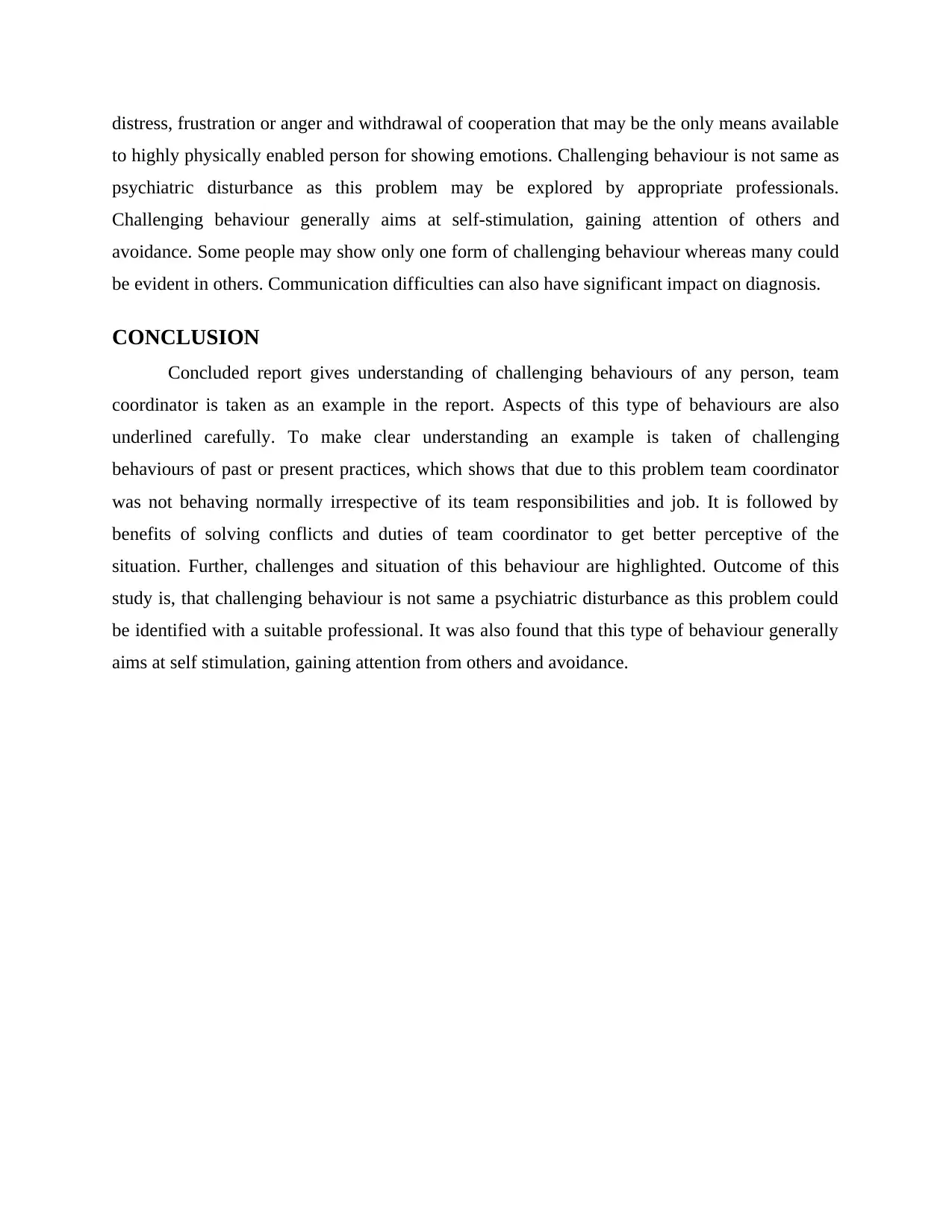
distress, frustration or anger and withdrawal of cooperation that may be the only means available
to highly physically enabled person for showing emotions. Challenging behaviour is not same as
psychiatric disturbance as this problem may be explored by appropriate professionals.
Challenging behaviour generally aims at self-stimulation, gaining attention of others and
avoidance. Some people may show only one form of challenging behaviour whereas many could
be evident in others. Communication difficulties can also have significant impact on diagnosis.
CONCLUSION
Concluded report gives understanding of challenging behaviours of any person, team
coordinator is taken as an example in the report. Aspects of this type of behaviours are also
underlined carefully. To make clear understanding an example is taken of challenging
behaviours of past or present practices, which shows that due to this problem team coordinator
was not behaving normally irrespective of its team responsibilities and job. It is followed by
benefits of solving conflicts and duties of team coordinator to get better perceptive of the
situation. Further, challenges and situation of this behaviour are highlighted. Outcome of this
study is, that challenging behaviour is not same a psychiatric disturbance as this problem could
be identified with a suitable professional. It was also found that this type of behaviour generally
aims at self stimulation, gaining attention from others and avoidance.
to highly physically enabled person for showing emotions. Challenging behaviour is not same as
psychiatric disturbance as this problem may be explored by appropriate professionals.
Challenging behaviour generally aims at self-stimulation, gaining attention of others and
avoidance. Some people may show only one form of challenging behaviour whereas many could
be evident in others. Communication difficulties can also have significant impact on diagnosis.
CONCLUSION
Concluded report gives understanding of challenging behaviours of any person, team
coordinator is taken as an example in the report. Aspects of this type of behaviours are also
underlined carefully. To make clear understanding an example is taken of challenging
behaviours of past or present practices, which shows that due to this problem team coordinator
was not behaving normally irrespective of its team responsibilities and job. It is followed by
benefits of solving conflicts and duties of team coordinator to get better perceptive of the
situation. Further, challenges and situation of this behaviour are highlighted. Outcome of this
study is, that challenging behaviour is not same a psychiatric disturbance as this problem could
be identified with a suitable professional. It was also found that this type of behaviour generally
aims at self stimulation, gaining attention from others and avoidance.
Paraphrase This Document
Need a fresh take? Get an instant paraphrase of this document with our AI Paraphraser
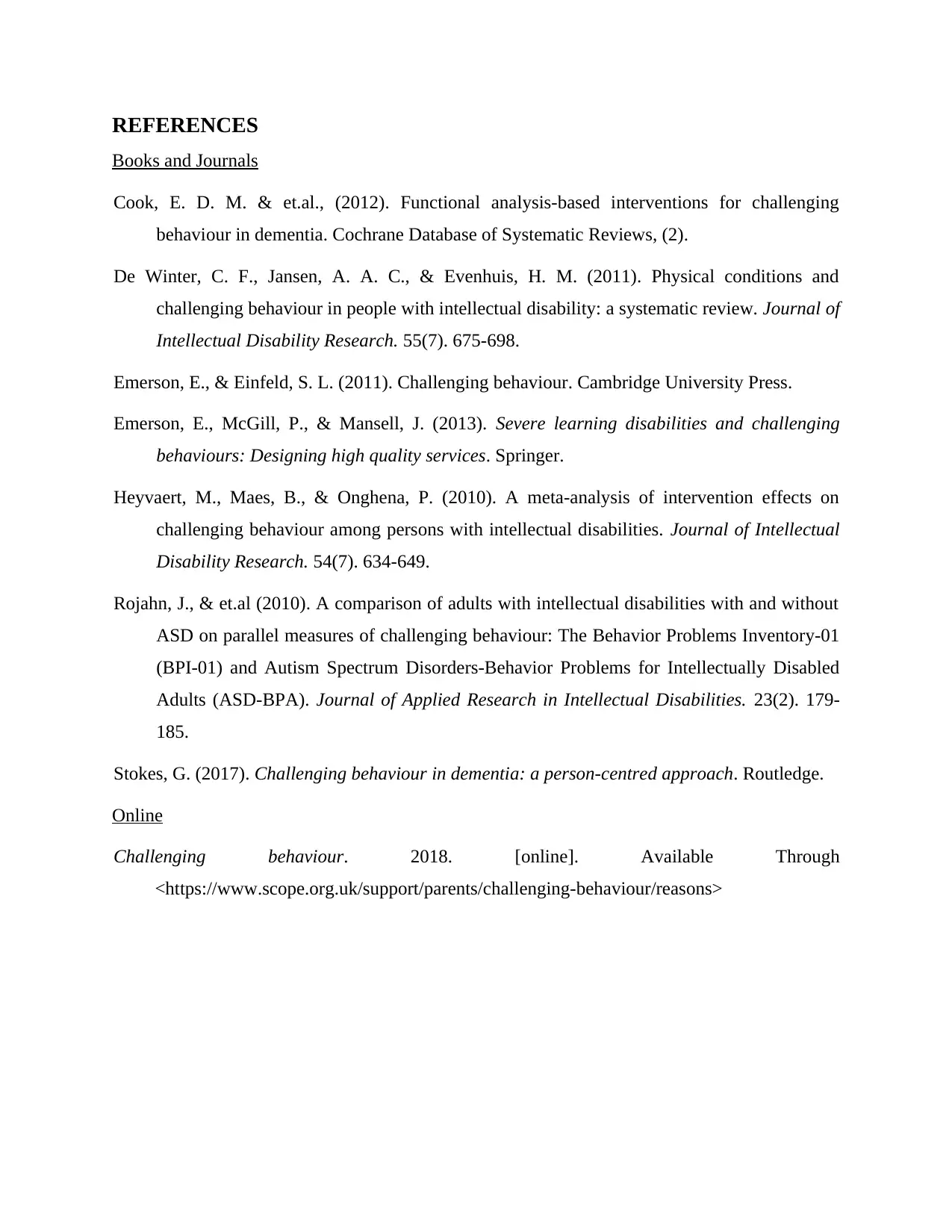
REFERENCES
Books and Journals
Cook, E. D. M. & et.al., (2012). Functional analysis‐based interventions for challenging
behaviour in dementia. Cochrane Database of Systematic Reviews, (2).
De Winter, C. F., Jansen, A. A. C., & Evenhuis, H. M. (2011). Physical conditions and
challenging behaviour in people with intellectual disability: a systematic review. Journal of
Intellectual Disability Research. 55(7). 675-698.
Emerson, E., & Einfeld, S. L. (2011). Challenging behaviour. Cambridge University Press.
Emerson, E., McGill, P., & Mansell, J. (2013). Severe learning disabilities and challenging
behaviours: Designing high quality services. Springer.
Heyvaert, M., Maes, B., & Onghena, P. (2010). A meta‐analysis of intervention effects on
challenging behaviour among persons with intellectual disabilities. Journal of Intellectual
Disability Research. 54(7). 634-649.
Rojahn, J., & et.al (2010). A comparison of adults with intellectual disabilities with and without
ASD on parallel measures of challenging behaviour: The Behavior Problems Inventory‐01
(BPI‐01) and Autism Spectrum Disorders‐Behavior Problems for Intellectually Disabled
Adults (ASD‐BPA). Journal of Applied Research in Intellectual Disabilities. 23(2). 179-
185.
Stokes, G. (2017). Challenging behaviour in dementia: a person-centred approach. Routledge.
Online
Challenging behaviour. 2018. [online]. Available Through
<https://www.scope.org.uk/support/parents/challenging-behaviour/reasons>
Books and Journals
Cook, E. D. M. & et.al., (2012). Functional analysis‐based interventions for challenging
behaviour in dementia. Cochrane Database of Systematic Reviews, (2).
De Winter, C. F., Jansen, A. A. C., & Evenhuis, H. M. (2011). Physical conditions and
challenging behaviour in people with intellectual disability: a systematic review. Journal of
Intellectual Disability Research. 55(7). 675-698.
Emerson, E., & Einfeld, S. L. (2011). Challenging behaviour. Cambridge University Press.
Emerson, E., McGill, P., & Mansell, J. (2013). Severe learning disabilities and challenging
behaviours: Designing high quality services. Springer.
Heyvaert, M., Maes, B., & Onghena, P. (2010). A meta‐analysis of intervention effects on
challenging behaviour among persons with intellectual disabilities. Journal of Intellectual
Disability Research. 54(7). 634-649.
Rojahn, J., & et.al (2010). A comparison of adults with intellectual disabilities with and without
ASD on parallel measures of challenging behaviour: The Behavior Problems Inventory‐01
(BPI‐01) and Autism Spectrum Disorders‐Behavior Problems for Intellectually Disabled
Adults (ASD‐BPA). Journal of Applied Research in Intellectual Disabilities. 23(2). 179-
185.
Stokes, G. (2017). Challenging behaviour in dementia: a person-centred approach. Routledge.
Online
Challenging behaviour. 2018. [online]. Available Through
<https://www.scope.org.uk/support/parents/challenging-behaviour/reasons>
1 out of 8
Related Documents
Your All-in-One AI-Powered Toolkit for Academic Success.
+13062052269
info@desklib.com
Available 24*7 on WhatsApp / Email
![[object Object]](/_next/static/media/star-bottom.7253800d.svg)
Unlock your academic potential
Copyright © 2020–2025 A2Z Services. All Rights Reserved. Developed and managed by ZUCOL.




